Citroen DS5 RHD 2014 1.G Owner's Guide
Manufacturer: CITROEN, Model Year: 2014, Model line: DS5 RHD, Model: Citroen DS5 RHD 2014 1.GPages: 400, PDF Size: 37.32 MB
Page 21 of 400
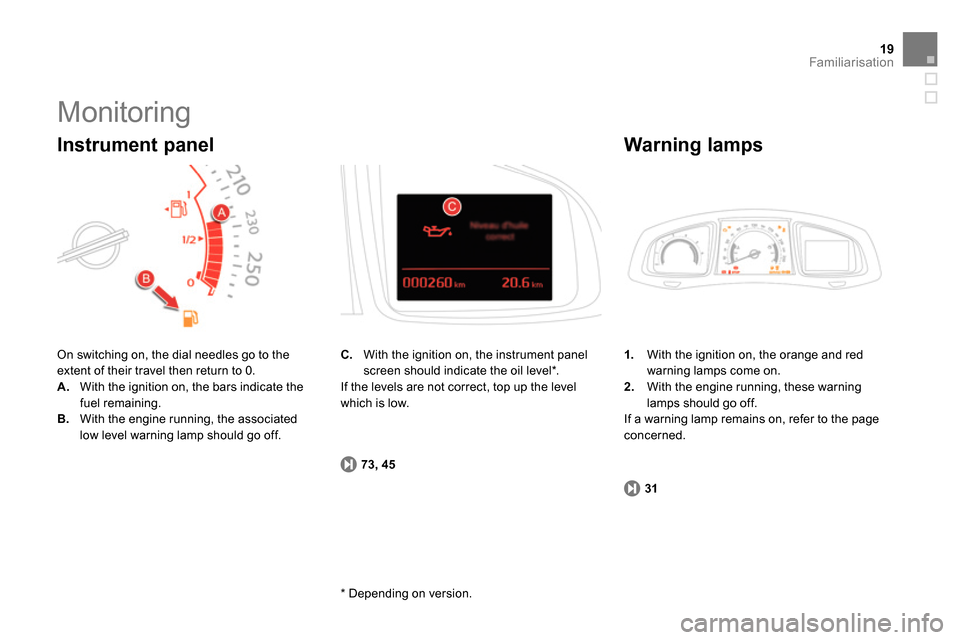
31 73, 45
19Familiarisation
1.
With the ignition on, the orange and red
warning lamps come on.
2.
With the engine running, these warning
lamps should go off.
If a warning lamp remains on, refer to the page
concerned.
Warning lamps
On switching on, the dial needles go to the
extent of their travel then return to 0.
A.
With the ignition on, the bars indicate the
fuel remaining.
B.
With the engine running, the associated
low level warning lamp should go off.
Instrument panel
C.
With the ignition on, the instrument panel
screen should indicate the oil level * .
If the levels are not correct, top up the level
which is low.
Monitoring
* Depending on version.
Page 22 of 400
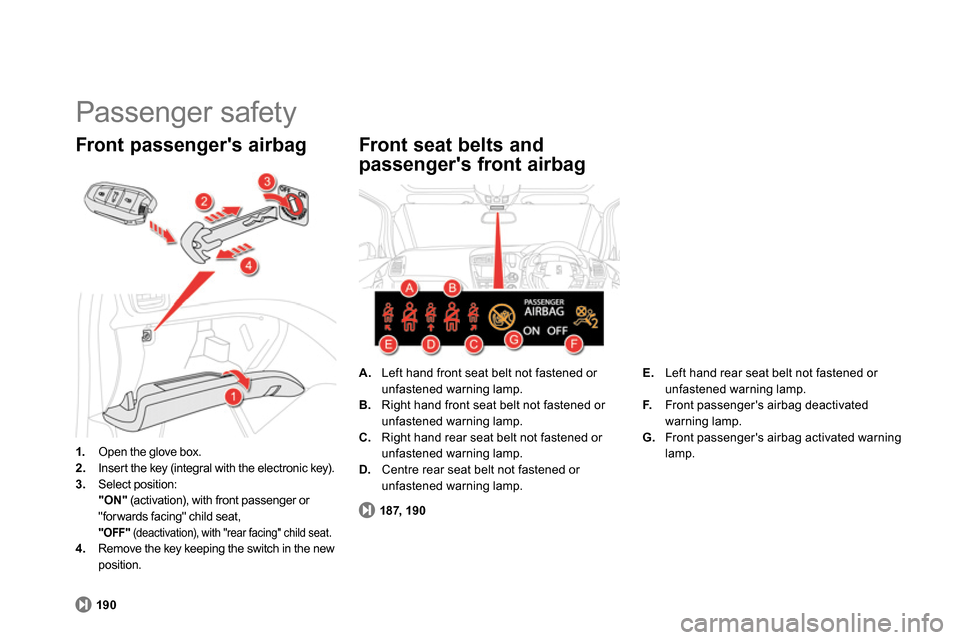
190187, 190
A.
Left hand front seat belt not fastened or
unfastened warning lamp.
B.
Right hand front seat belt not fastened or
unfastened warning lamp.
C.
Right hand rear seat belt not fastened or
unfastened warning lamp.
D.
Centre rear seat belt not fastened or
unfastened warning lamp.
Front seat belts and
passenger's front airbag
E.
Left hand rear seat belt not fastened or
unfastened warning lamp.
F.
Front passenger's airbag deactivated
warning lamp.
G.
Front passenger's airbag activated warning
lamp.
1.
Open the glove box.
2.
Insert the key (integral with the electronic key).
3.
Select position:
"ON"
(activation), with front passenger or
"for wards facing" child seat,
"OFF"
(deactivation), with "rear facing" child seat.
4.
Remove the key keeping the switch in the new
position.
Front passenger's airbag
Passenger safety
Page 23 of 400
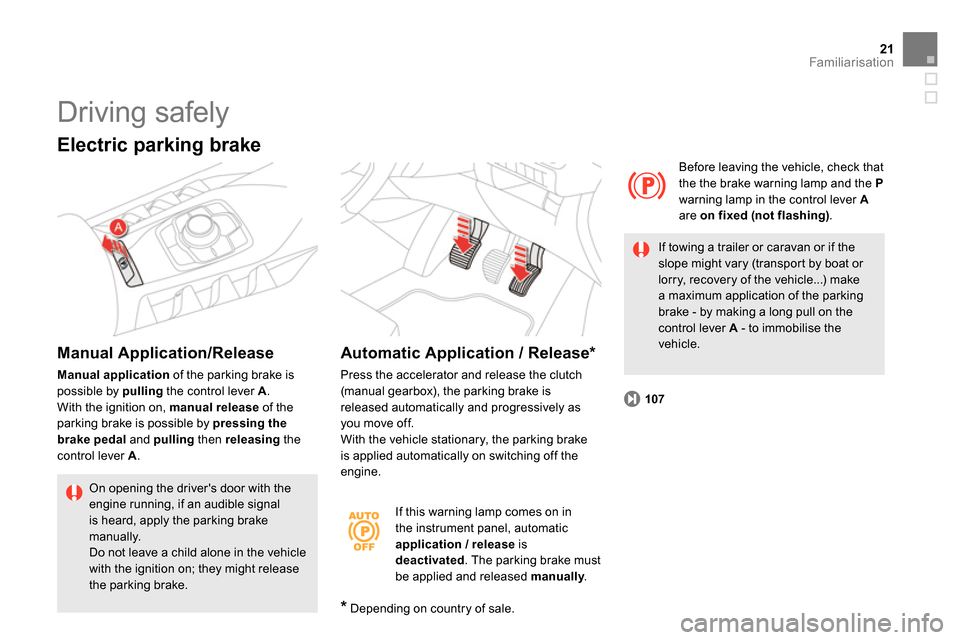
107
21Familiarisation
If this warning lamp comes on in
the instrument panel, automatic
application / release
is
deactivated
. The parking brake must
be applied and released manually
.
Before leaving the vehicle, check that
the the brake warning lamp and the P
warning lamp in the control lever A
are on fixed (not flashing)
.
If towing a trailer or caravan or if the
slope might vary (transport by boat or
lorry, recovery of the vehicle...) make
a maximum application of the parking
brake - by making a long pull on the
control lever A
- to immobilise the
vehicle.
*
Depending on country of sale.
Automatic Application / Release *
Press the accelerator and release the clutch
(manual gearbox), the parking brake is
released automatically and progressively as
you move off.
With the vehicle stationary, the parking brake
is applied automatically on switching off the
engine.
On opening the driver's door with the
engine running, if an audible signal
is heard, apply the parking brake
manually.
Do not leave a child alone in the vehicle
with the ignition on; they might release
the parking brake.
Manual Application/Release
Manual application
of the parking brake is
possible by pulling
the control lever A
.
With the ignition on, manual release
of the
parking brake is possible by pressing the
brake pedal
and pulling
then releasing
the
control lever A
.
Electric parking brake
Driving safely
Page 24 of 400
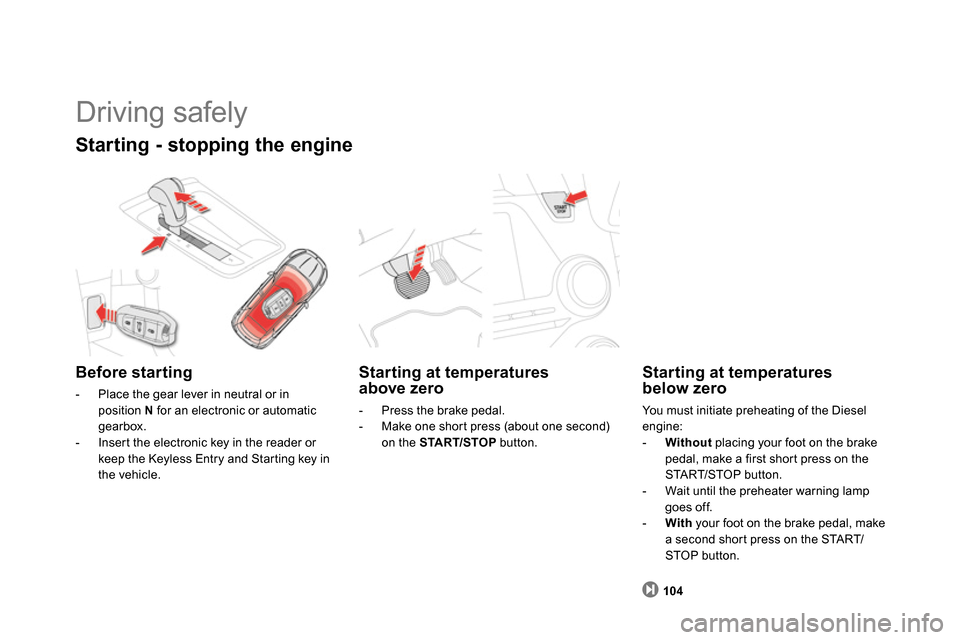
104
Starting at temperatures
above zero
- Press the brake pedal.
- Make one short press (about one second)
on the START/STOP
button.
Starting at temperatures
below zero
You must initiate preheating of the Diesel
engine:
- Without
placing your foot on the brake
pedal, make a first short press on the
START/STOP button.
- Wait until the preheater warning lamp
goes off.
- With
your foot on the brake pedal, make
a second short press on the START/
STOP button.
Driving safely
Starting - stopping the engine
Before starting
- Place the gear lever in neutral or in
position N
for an electronic or automatic
gearbox.
- Insert the electronic key in the reader or
keep the Keyless Entry and Starting key in
the vehicle.
Page 25 of 400

13 4
136124
23Familiarisation
Driving safely
Speed limiter "LIMIT"
1.
Selecting speed limiter mode.
2.
Decrease the programmed value.
3.
Increase the programmed value.
4.
Pause/resume speed limiter.
5.
Display of the memorised speeds (by the
audio system memory).
These values must be set with the engine running.
Cruise control "CRUISE"
1.
Selecting cruise control mode.
2.
Programming a speed / Decrease the
programmed value.
3.
Programming a speed / Increase the
programmed value.
4.
Pause/resume cruise control.
5.
Display of the memorised speeds (by the
audio system memory).
In order to be programmed or activated, the
vehicle speed must be higher than 25 mph
(40 km/h), with at least 4th gear engaged on a
manual gearbox (2nd gear on an electronic or
automatic gearbox).
Display in the instrument panel
The cruise control or speed limiter mode
appears in the instrument panel when it is
selected.
Gear efficiency indicator
The system may suggest the most suitable
gear to select.
Page 26 of 400
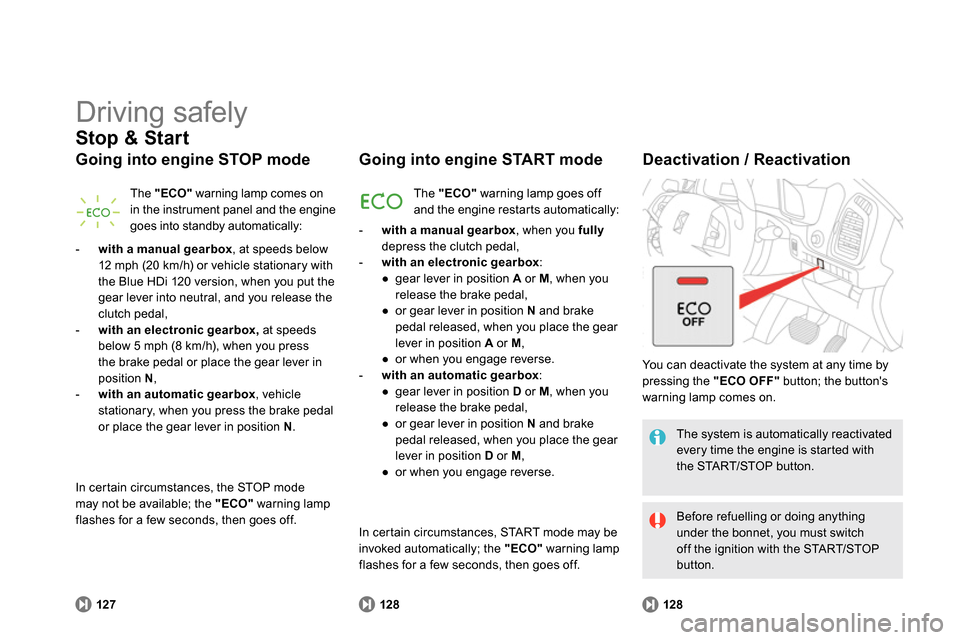
127
128 128
Driving safely
Stop & Start
Going into engine STOP mode
The "ECO"
warning lamp comes on
in the instrument panel and the engine
goes into standby automatically:
Going into engine START mode
Deactivation / Reactivation
The system is automatically reactivated
every time the engine is started with
the START/STOP button.
Before refuelling or doing anything
under the bonnet, you must switch
off the ignition with the START/STOP
button.
The "ECO"
warning lamp goes off
and the engine restarts automatically:
- with a manual gearbox
, when you fully
depress the clutch pedal,
- with an electronic gearbox
:
●
gear lever in position A
or M
, when you
release the brake pedal,
●
or gear lever in position N
and brake
pedal released, when you place the gear
lever in position A
or M
,
●
or when you engage reverse.
- with
an
automatic gearbox
:
●
gear lever in position D
or M
, when you
release the brake pedal,
●
or gear lever in position N
and brake
pedal released, when you place the gear
lever in position D
or M
,
●
or when you engage reverse.
You can deactivate the system at any time by
pressing the "ECO OFF"
button; the button's
warning lamp comes on.
- with a manual gearbox
, at speeds below
12 mph (20 km/h) or vehicle stationary with
the Blue HDi 120 version, when you put the
gear lever into neutral, and you release the
clutch pedal,
- with an electronic gearbox,
at speeds
below 5 mph (8 km/h), when you press
the brake pedal or place the gear lever in
position N
,
-
with an automatic gearbox
, vehicle
stationary, when you press the brake pedal
or place the gear lever in position N
.
In certain circumstances, the STOP mode
may not be available; the "ECO"
warning lamp
flashes for a few seconds, then goes off.
In certain circumstances, START mode may be
invoked automatically; the "ECO"
warning lamp
flashes for a few seconds, then goes off.
Page 27 of 400
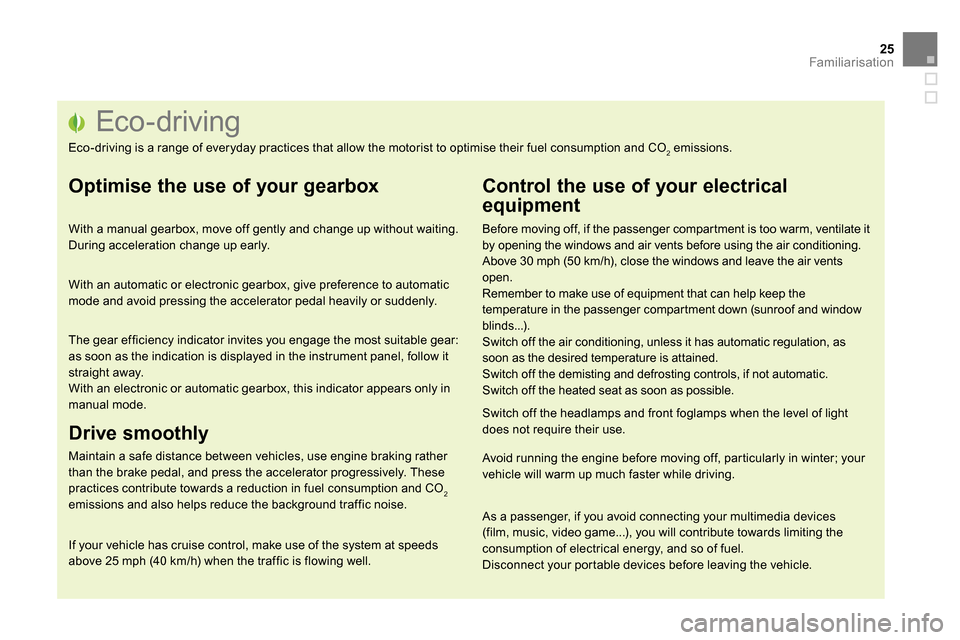
25Familiarisation
Eco-driving
Eco-driving is a range of everyday practices that allow the motorist to optimise their fuel consumption and CO2 emissions.
Optimise the use of your gearbox
With a manual gearbox, move off gently and change up without waiting.
During acceleration change up early.
With an automatic or electronic gearbox, give preference to automatic
mode and avoid pressing the accelerator pedal heavily or suddenly.
The gear efficiency indicator invites you engage the most suitable gear:
as soon as the indication is displayed in the instrument panel, follow it
straight away.
With an electronic or automatic gearbox, this indicator appears only in
manual mode.
Drive smoothly
Maintain a safe distance between vehicles, use engine braking rather
than the brake pedal, and press the accelerator progressively. These
practices contribute towards a reduction in fuel consumption and CO
2
emissions and also helps reduce the background traffic noise.
If your vehicle has cruise control, make use of the system at speeds
above 25 mph (40 km/h) when the traffic is flowing well.
Control the use of your electrical
equipment
Before moving off, if the passenger compartment is too warm, ventilate it
by opening the windows and air vents before using the air conditioning.
Above 30 mph (50 km/h), close the windows and leave the air vents
open.
Remember to make use of equipment that can help keep the
temperature in the passenger compartment down (sunroof and window
blinds...).
Switch off the air conditioning, unless it has automatic regulation, as
soon as the desired temperature is attained.
Switch off the demisting and defrosting controls, if not automatic.
Switch off the heated seat as soon as possible.
Switch off the headlamps and front foglamps when the level of light
does not require their use.
Avoid running the engine before moving off, particularly in winter; your
vehicle will warm up much faster while driving.
As a passenger, if you avoid connecting your multimedia devices
(film, music, video game...), you will contribute towards limiting the
consumption of electrical energy, and so of fuel.
Disconnect your portable devices before leaving the vehicle.
Page 28 of 400

Limit the causes of excess consumption
Spread loads throughout the vehicle; place the heaviest items in the
bottom of the boot, as close as possible to the rear seats.
Limit the loads carried in the vehicle and reduce wind resistance (roof
bars, roof rack, bicycle carrier, trailer...). Use a roof box in preference.
Remove roof bars and roof racks after use.
At the end of winter, remove snow tyres and refit your summer tyres.
Observe the recommendations on maintenance
Check the tyre pressures regularly, when cold, referring to the label in
the door aperture, driver's side.
Carry out this check in particular:
- before a long journey,
- at each change of season,
- after a long period out of use.
Don't forget the spare wheel and the tyres on any trailer or caravan.
Have your vehicle ser viced regularly (engine oil, oil filter, air filter...) and
obser ve the schedule of operations recommended by the manufacturer.
When refuelling, do not continue after the third cut-off of the nozzle to
avoid any over flow.
At the wheel of your new vehicle, it is only after the first 1 800 miles
(3 000 kilometres) that you will see the fuel consumption settle down
to a consistent average.
Page 29 of 400

27Familiarisation
Page 30 of 400

001
Instruments and controls